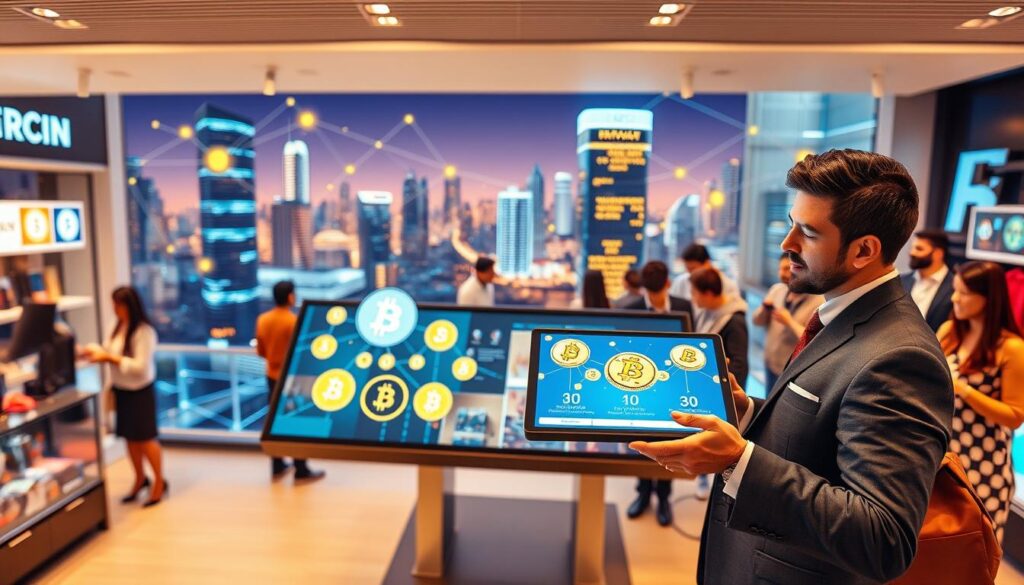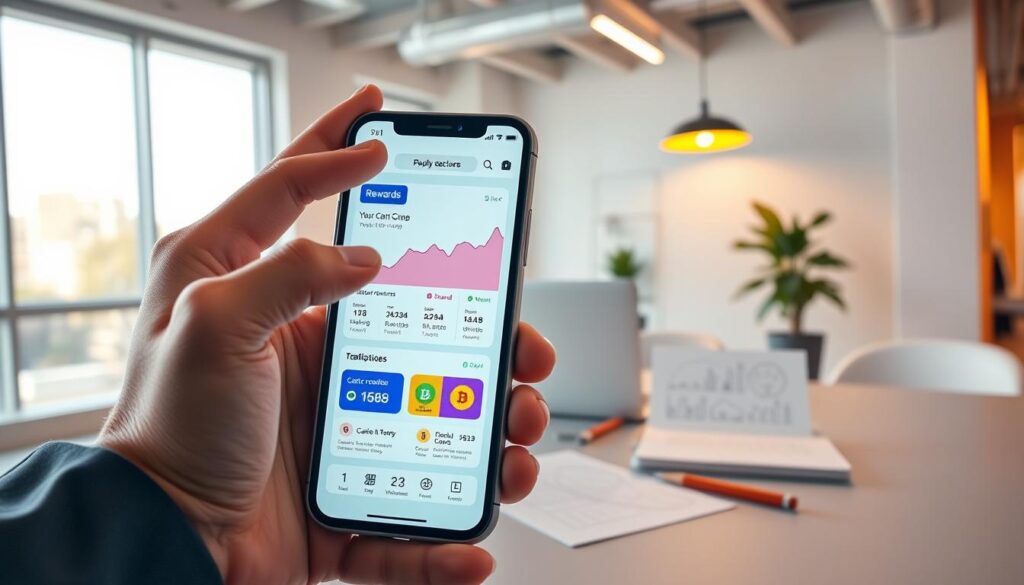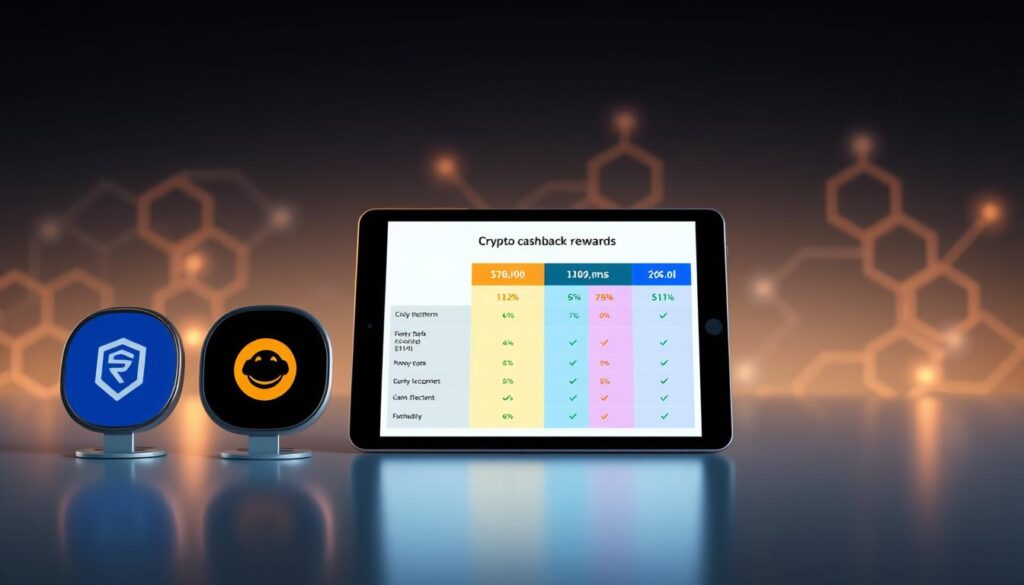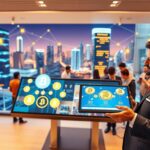Now Reading: Unlock the Power of Real World Assets with Crypto
- 01
Unlock the Power of Real World Assets with Crypto
Unlock the Power of Real World Assets with Crypto
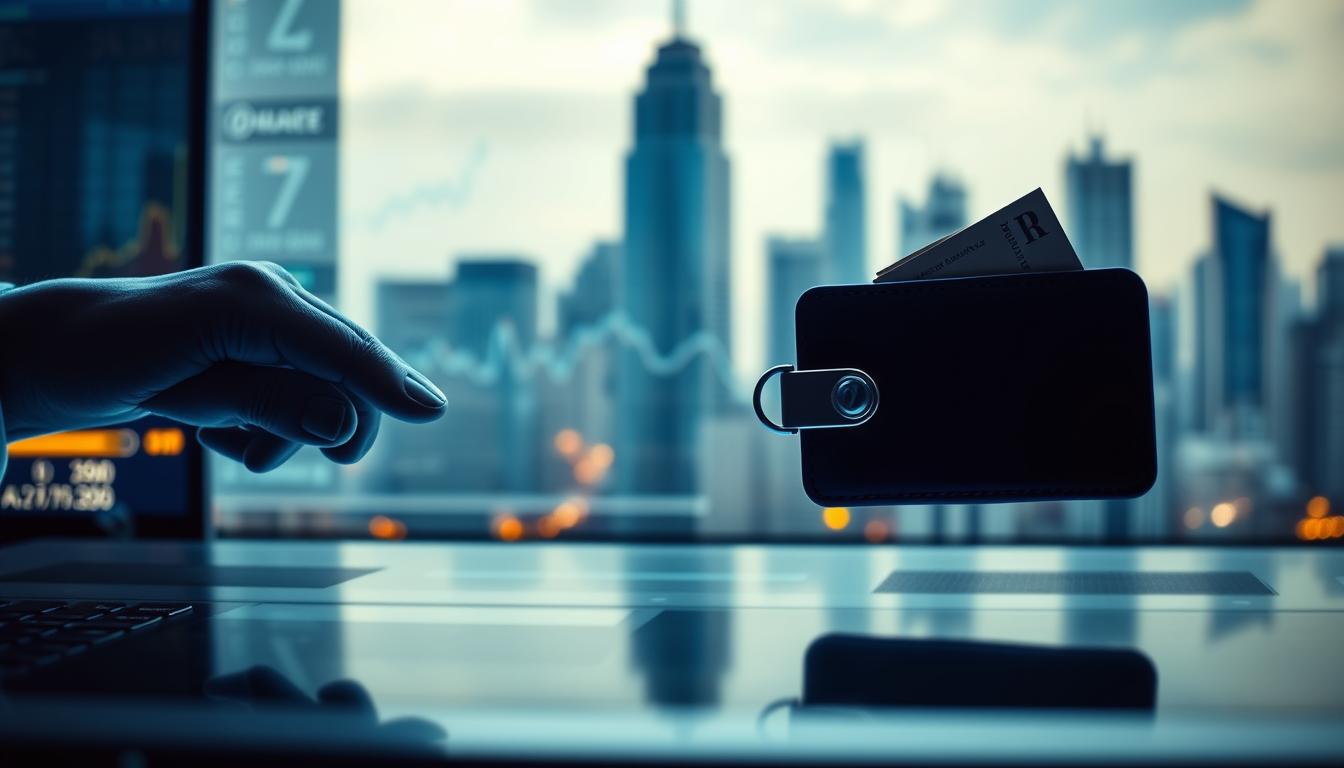
The mix of real-world assets with crypto is changing how we view ownership and investing.
Thanks to tokenization of assets, people can now explore more investment options. This includes real estate and art.

This blend of old assets with digital finance opens up new chances for growth. It makes crypto asset management key for today’s investors.
Key Takeaways
- Tokenization of assets is increasing investment opportunities.
- Crypto asset management is becoming crucial for modern investors.
- The integration of real-world assets with crypto is driving growth.
- Digital finance is revolutionizing traditional investment methods.
- New avenues for diversification are emerging through tokenization.
The Convergence of Traditional Assets and Digital Finance
Blockchain technology is leading the way in combining traditional assets with digital finance. This change is not just about new tech. It’s about changing how we own, manage, and trade assets.
Defining Real World Assets in the Digital Age
In today’s digital world, real-world assets (RWAs) are things we can touch or own digitally. They’re often turned into tokens on a blockchain. This makes them more secure, transparent, and accessible.
Tokenizing assets means turning their ownership into a digital token. This token can be stored, traded, or managed online.
The good things about tokenizing assets include:
- More liquidity thanks to fractional ownership
- Better security and transparency with blockchain
- More people can invest thanks to easier access
Why Blockchain Technology is Transforming Asset Ownership
Blockchain is changing how we own assets by using a decentralized, unchangeable ledger. This ledger keeps track of transactions and who owns what. It makes digital assets more secure and opens up new financial options.
Blockchain’s key features that change asset ownership are:
- Decentralization: It cuts down on middlemen and speeds up deals.
- Immutable Ledger: It keeps ownership records safe and clear.
- Smart Contracts: They make sure contracts are followed and carried out automatically.
With these features, blockchain is changing how we own and manage assets. It’s making things more efficient, secure, and open to everyone.
Real World Assets Crypto: Understanding the Fundamentals
The mix of real-world assets with cryptocurrency is changing how we see and deal with traditional assets. This blend is thanks to tokenization. It turns physical or intangible assets into digital tokens. These tokens can be stored, traded, and managed on blockchain platforms.
The Tokenization Process Explained
Tokenization creates a digital version of an asset. This can be real estate, art, or a commodity. First, the asset is identified and valued. Then, a digital token that shows ownership or a claim is made.
This token is issued on a blockchain. This makes it secure, transparent, and safe from tampering. Tokenization of assets lets many investors own a piece of a valuable asset.
Tokenization brings more liquidity and transparency. Tokens can be traded online, and all transactions are recorded on the blockchain. It also cuts down on costs by reducing the need for middlemen.
Key Technologies Enabling Asset Tokenization
Several technologies make tokenizing real-world assets possible. Blockchain technology is key for a secure and transparent ledger. Smart contracts automate token issuance and transfer.
Also, non-fungible tokens (NFTs) and asset-backed tokens represent unique or fungible assets. These technologies make tokens secure, tradable, and follow rules.

Together, these technologies make tokenization easy and safe. As the field grows, we’ll see new uses of tokenization in different asset types.
Benefits of Bringing Real-World Assets On-Chain
By integrating real-world assets with blockchain, we open up new chances for liquidity and access. This mix of traditional and digital assets is making finance more robust and open to everyone.
Increased Liquidity and Market Efficiency
Turning real-world assets into tokens boosts market liquidity. For example, tokenized real estate lets people own fractions of property. This makes buying and selling easier and faster.
Blockchain technology also brings transparency and cuts fraud risks. This makes markets more efficient and reliable.
Democratizing Access to Premium Assets
Tokenizing assets makes them available to more people. Before, only the rich or big investors could access them. Now, anyone can invest in things like art or real estate with less money.
This opens up new cryptocurrency investment opportunities. For instance, platforms let you buy parts of expensive art. This makes high-value items more reachable.
Reducing Costs Through Disintermediation
Blockchain cuts down on the need for middlemen like brokers. Decentralized finance (DeFi) protocols let people trade directly or lend without banks. This lowers costs and speeds up transactions.
Investors get to keep more of their money. This makes crypto asset management more efficient and profitable.
In summary, on-chain real-world assets bring many benefits. They increase liquidity, make assets more accessible, and cut costs. As blockchain tech grows, we’ll see even more creative uses in decentralized finance assets.
Types of Real-World Assets Suitable for Tokenization
Tokenization is changing how we view ownership and investment. It uses blockchain to turn assets into digital tokens. This makes them more liquid and accessible.
Real Estate and Property Markets
Real estate is a big winner with tokenization. Blockchain technology real estate is changing how we buy, sell, and own properties.
Residential vs. Commercial Opportunities
Both homes and commercial buildings are being tokenized. This gives investors many options. It also makes it easier to spread out investments.
REITs on the Blockchain
Blockchain is teaming up with Real Estate Investment Trusts (REITs). This creates asset-backed tokens for real estate. It’s a secure, clear way to invest in property.

Art, Collectibles, and Luxury Items
The art world is getting into tokenization with non-fungible tokens (NFTs). These digital assets show ownership of art, collectibles, and luxury goods. They offer a new way for artists to earn and for collectors to buy and trade.
Commodities and Natural Resources
Things like gold, oil, and other natural resources are being tokenized. This makes trading and owning them more efficient. Asset-backed tokens for these commodities are traded on blockchain, improving market liquidity.
Intellectual Property and Revenue Streams
Intellectual property, like patents and copyrights, can also be tokenized. This lets creators turn their future earnings into immediate capital. It gives investors a chance to back creative projects.
Tokenization is creating new ways to invest and own different types of assets. As blockchain tech grows, we’ll see even more creative uses in the real world.
How to Evaluate Blockchain Platforms for RWA Projects
As RWA tokenization grows, picking the right blockchain platform is key. The platform you choose affects your project’s security, efficiency, and growth. It’s all about making sure your digital assets are safe and work well.
Assessing Smart Contract Capabilities
Smart contracts are vital for RWA tokenization, making transactions safe and automatic. When looking at blockchain platforms, check their smart contract abilities. Look for platforms that are flexible, secure, and can grow with your needs.
- Flexibility in contract creation
- Security features to prevent vulnerabilities
- Scalability to handle high transaction volumes
Comparing Layer1 and Layer2 Solutions
Blockchain platforms come in two main types: Layer1 and Layer2. Layer1 is the core, offering basic security and decentralization. Layer2 adds scalability and efficiency on top. Think about what your RWA project needs, like decentralized finance assets integration.
Interoperability Considerations
Interoperability is key for RWA projects’ success. It lets different blockchain networks and traditional finance systems work together smoothly. Check if the platform supports cross-chain transactions and fits with current financial systems. This is crucial for good crypto asset management.
Step-by-Step Guide to Tokenizing Your First Real-World Asset
Blockchain technology has made tokenizing real-world assets easier than before. This process turns an asset’s rights into a digital token on a blockchain. It offers a new way to invest and own assets.

1. Asset Selection and Due Diligence
Choosing the right asset is the first step. You need to check its value, legal status, and market liquidity. Due diligence is crucial to make sure the asset is good for tokenization and follows the law.
2. Legal Structure and Regulatory Compliance
It’s important to know and follow the law. You must set up the tokenization process to meet legal standards. Legal counsel experienced in blockchain and securities law can help a lot during this step.
3. Token Economics and Design
Deciding on the token’s supply, distribution, and rules is key. This ensures the token is appealing to investors and meets the owner’s goals. Tokenomics must balance everyone’s interests.
4. Technical Implementation and Launch
Choosing a blockchain platform and creating smart contracts is the technical part. The launch needs careful planning to smoothly move to the blockchain model.
5. Creating Liquidity and Market Access
It’s important to make the token liquid and accessible. This can be done by listing it on exchanges or creating liquidity pools. Market access boosts the asset’s appeal to more investors.
Tokenizing assets is complex but rewarding. By following these steps and using blockchain, owners can open new investment doors. They can also make markets more efficient and transparent.
How to Invest in Tokenized Real-World Assets
Tokenized real-world assets offer new ways for investors to diversify. They are a big step forward in finance, making it easy to own digital versions of things like real estate and art.
Direct Purchase of Asset-Backed Tokens
Investing in these assets means buying asset-backed tokens. These tokens show you own a piece of something, like a house or a collection of art. It’s important to check the token’s basics before buying.
Evaluating Token Fundamentals
Look at the underlying asset’s value, the market liquidity, and the issuer’s credibility when checking tokens. Knowing these things helps you make smart choices.
Due Diligence Checklist
- Verify the asset’s ownership and legal structure
- Assess the token’s smart contract security
- Evaluate the platform’s reputation and user reviews
- Understand the fees associated with buying and holding the token
Participating in RWA-Focused DeFi Protocols
Investing in tokenized assets also means joining decentralized finance (DeFi) protocols focused on RWAs. These platforms let you lend, borrow, and earn interest with tokenized assets.
By lending or providing liquidity, you can earn interest on your investment.
Building a Diversified RWA Portfolio
It’s key to have a diversified portfolio of tokenized assets. Spread your investments across different types, like real estate and art.
This way, you can reduce risks and maybe see better returns over time. Keep checking and tweaking your portfolio to match your goals.
Navigating the Regulatory Landscape
As more real-world assets are turned into tokens, knowing the rules is key. The rules for digital assets are complex and keep changing. It’s important to follow them closely to avoid problems.
US Regulatory Framework for Tokenized Assets
In the United States, there are many rules for tokenized assets. The Securities and Exchange Commission (SEC) watches over tokenized securities. The Commodity Futures Trading Commission (CFTC) looks after digital commodities. Knowing these rules well is a must for following the law. For more on legal matters, check out this resource.
Global Regulatory Approaches and Jurisdictions
Every country has its own way of handling tokenized assets. Places like Switzerland and Singapore have rules that are friendly to crypto. But, other countries are more careful or strict. It’s important to know these differences if you plan to work in many places.
Implementing Compliance Protocols
Having good rules in place is crucial for handling risks with tokenized assets. This means having Anti-Money Laundering (AML) and Know Your Customer (KYC) steps. It also means being clear about how tokens are made and traded. By following these steps, companies can earn trust from both regulators and investors.

Managing Risks in Tokenized Asset Investments
More investors are looking into tokenized assets. But, it’s key to know the risks. These assets offer new chances but also bring unique challenges.
Technical Security Best Practices
Keeping tokenized assets safe is a top priority. This means using strong digital assets security steps, like:
- Multi-signature wallets for extra security
- Regular security checks to find weak spots
- Using trusted custody solutions to protect assets
Following these steps can greatly lower the chance of asset loss.
Legal and Regulatory Risk Mitigation
It’s vital to understand the legal and regulatory side of tokenized assets. Investors should:
- Keep up with changing rules
- Make sure they follow local laws
- Work with legal pros to set up investments right
For more on legal risks, check out Antier Solutions for detailed advice.
Addressing Market and Liquidity Challenges
Tokenized assets face market ups and downs and liquidity issues. Good crypto asset management means:
- Spreading out your investments to lessen risk
- Watching market trends and adjusting plans
- Using DeFi to improve liquidity
By tackling these issues head-on, investors can handle the complex world of tokenized assets better.
Real-World Success Stories: Case Studies in RWA Tokenization
Real-world asset tokenization has become a reality, with many examples showing its power. It combines blockchain technology with traditional assets. This mix is creating new ways to own and invest in things.
RealT: Fractional Real Estate Ownership
RealT is changing the real estate world with blockchain. It lets people own parts of properties, not just the whole thing. This makes real estate more accessible and liquid.
Properties are turned into tokens on the Ethereum blockchain. This makes buying and selling parts of properties easy. Investors get a share of the rental income based on how much they own.
Masterworks: Fine Art Tokenization
Masterworks is leading the way in tokenizing fine art. It lets investors buy shares in famous artworks. This makes buying, selling, and trading art more efficient.
This platform opens the art market to more people. It also solves the problem of art being hard to sell. Investors can add art to their portfolios, knowing their ownership is secure thanks to blockchain.
Paxos Gold: Commodity-Backed Tokens
Paxos Gold (PAXG) is a token backed by real gold. Each token is one fine troy ounce of gold, kept in London vaults. Paxos Gold mixes blockchain tech with gold’s stability, offering a secure way to own and trade gold.
PAXG tokens are found on many cryptocurrency exchanges. This makes investing in gold easy and modern. It shows how blockchain can change how we invest in and own assets.
Essential Tools for Managing Your Tokenized Asset Portfolio
Managing a tokenized asset portfolio means using the right tools for security, tracking, and analysis. As the world of tokenized assets grows, investors and managers need to know about the latest tools. These tools help manage portfolios well.
Secure Custody Solutions
Keeping tokenized assets safe is key. Solutions like Ledger and Fireblocks have strong security features. They offer multi-signature wallets and cold storage. These platforms keep digital assets safe, letting investors manage their portfolios with confidence.
- Multi-signature wallet support
- Cold storage solutions
- Advanced encryption techniques
Portfolio Tracking and Management Platforms
Good portfolio management needs real-time tracking and analytics. Platforms like Delta and Blockfolio let investors watch their assets on different exchanges and wallets. These tools give a clear view of how portfolios are doing, helping investors make smart choices.
- Real-time price tracking
- Portfolio performance analytics
- Alerts for market movements
Analytics and Valuation Resources
Knowing the value and potential of tokenized assets is key for smart investment choices. Resources like CoinMarketCap and Nansen offer detailed analytics and valuation data. These platforms help investors understand market trends, asset performance, and risks.
Future Trends in Real World Assets Tokenization
The future of Real World Assets (RWA) tokenization is set to change how we invest and own things. The industry is growing, and we’ll see new tech and market growth.
Emerging Technologies and Integration Possibilities
New tech is coming to make tokenization better. This includes artificial intelligence and blockchain upgrades. These will make RWA tokenization more efficient and secure.
- Integration with Internet of Things (IoT) devices
- Use of machine learning for predictive analytics
- Development of more sophisticated smart contracts
For more insights on the growing market for tokenized real-world assets, you can read this article on Medium.
Market Growth Projections and Adoption Curves
The market for RWA tokenization is set to grow a lot. The global market size is expected to hit $ trillions by 2025.
- Increased adoption in the real estate sector
- Growing demand for cryptocurrency investment opportunities
- Expansion into new asset classes, such as decentralized finance assets
This growth will come from a need for better investment options. As the industry grows, we’ll see new trends and ideas.
Taking Action: Your Roadmap to RWA Investment Success
Real world assets crypto is changing how we invest and manage assets. To succeed, you need a clear plan. Start by learning about tokenization and its benefits for traditional assets.
Managing your crypto assets well is essential in the RWA world. This means picking the right blockchain platforms, following the rules, and handling risks. Diversifying your investments across different RWAs helps reduce risks and find new opportunities.
To do well, keep up with market trends and rule changes. Use tools like secure storage and portfolio tracking to manage your assets. As the RWA market grows, being ready and flexible is key to your success.
Follow this roadmap and stay focused on your goals. This way, you can fully benefit from real world assets crypto and achieve lasting success.
FAQ
What are real-world assets in the context of cryptocurrency?
Real-world assets are things we can touch or own, like houses, art, or gold. They are being turned into digital tokens using cryptocurrency.
How does blockchain technology transform asset ownership?
Blockchain makes owning assets safer and more open. It uses a secure, shared record to show who owns what. This cuts out middlemen and makes things more efficient.
What is the tokenization process, and how does it work?
Tokenization turns real assets into digital tokens. These tokens can be stored and traded online. They show who owns what in the real world.
What are the benefits of bringing real-world assets on-chain?
Putting real assets online makes them easier to buy and sell. It opens up premium assets to more people. It also lowers costs by cutting out middlemen.
What types of real-world assets are suitable for tokenization?
Many assets can be tokenized, like houses, art, and even ideas. This offers a wide range of investment choices.
How do I evaluate blockchain platforms for RWA projects?
Look at a platform’s smart contracts, security, and how it works with other systems. Make sure it fits your needs.
What are the key steps to tokenizing a real-world asset?
First, pick an asset and do your homework. Then, set up the legal side and design the token. Next, implement it and make it liquid. This is how you tokenize an asset.
How can I invest in tokenized real-world assets?
You can buy tokens directly or join DeFi projects. You can also diversify your portfolio. There are many ways to invest.
What are the regulatory considerations for tokenized assets?
Know the US and global laws for these assets. Make sure you follow them to avoid trouble.
How can I manage risks associated with tokenized asset investments?
Focus on security, legal compliance, and market stability. This helps reduce risks.
What are some successful examples of RWA tokenization?
RealT, Masterworks, and Paxos Gold are examples. They show how tokenization works in different areas, like real estate and art.
What tools are essential for managing a tokenized asset portfolio?
You need secure storage, tracking tools, and analytics. These help you make smart choices.


